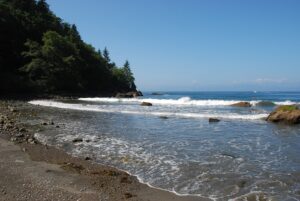
PROCEEDINGS OF THE NATIONAL ACADEMY OF SCIENCES—Models and paleoceanographic data reveal climatically favorable intervals when humans could have traversed the Cordilleran coastal corridor during the terminal Pleistocene Epoch, according to a study. Human dispersal pathways from Beringia into North America continue to be debated. Summer Praetorius and colleagues analyzed new records of sea ice variations and synthesized previously published reconstructions of sea ice, sea surface temperature, salinity, and ice-rafted debris from marine sediment cores in the North Pacific Ocean. The model results showed that the average strength of the Alaska Current more than doubled along the Southeast Alaska margin during the Last Glacial Maximum (LGM), compared with modern conditions. The accelerated currents might have impeded southward seafaring migration. In addition, Gulf of Alaska shorelines had extensive seasonal sea ice during the LGM, which was the most recent time during the Last Glacial Period that ice sheets were at their greatest extent. The results suggest that environmentally favorable time periods for coastal migration after glacial retreat events include two spans: from 24,500 to 22,000 years ago and between 16,400 and 14,800 years ago. During these periods, regional climate conditions may have provided both winter sea ice and summer kelp ecosystems for year-round marine resource diversity, which may have facilitated human dispersal along the Cordilleran coastal corridor. Together, the data help discern major climate and oceanographic changes that may have facilitated and impeded human migration during the terminal Pleistocene Epoch.
________________________________

Pacific northwest coast. Mrs. Brown, Pixabay
________________________________
Article Source: PNAS news release
*“Ice and ocean constraints on early human migrations into North America along the Pacific coast,” by Summer Praetorius et al., Proceedings of the National Academy of Sciences, 6-Feb-2023. https://www.pnas.org/cgi/doi/10.1073/pnas.2208738120
________________________________
Advertisement

Don’t miss out on this unforgettable evening as Dr. Hawass reveals the most closely guarded secrets of ancient Egypt and presents his groundbreaking new discoveries and latest research live on stage. As the man behind all major discoveries in Egypt over the last few decades and director of several ongoing archaeological projects, Dr. Hawass may yet surprise you with unexpected revelations that will make news across the world.
________________________________
Advertisement





